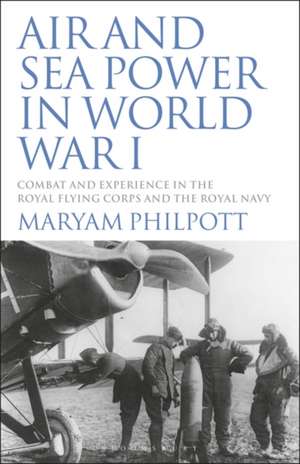Air and Sea Power in World War I: Combat and Experience in the Royal Flying Corps and the Royal Navy
Autor Maryam Philpotten Limba Engleză Paperback – 29 apr 2020
Preț: 223.67 lei
Preț vechi: 257.23 lei
-13% Nou
Puncte Express: 336
Preț estimativ în valută:
42.80€ • 44.22$ • 35.62£
42.80€ • 44.22$ • 35.62£
Carte tipărită la comandă
Livrare economică 25 martie-08 aprilie
Preluare comenzi: 021 569.72.76
Specificații
ISBN-13: 9781350160248
ISBN-10: 1350160245
Pagini: 272
Dimensiuni: 135 x 216 mm
Greutate: 0.32 kg
Editura: Bloomsbury Publishing
Colecția Bloomsbury Academic
Locul publicării:London, United Kingdom
ISBN-10: 1350160245
Pagini: 272
Dimensiuni: 135 x 216 mm
Greutate: 0.32 kg
Editura: Bloomsbury Publishing
Colecția Bloomsbury Academic
Locul publicării:London, United Kingdom
Caracteristici
Explores the changing reputation of national services during and after the First World War
Notă biografică
Maryam Philpott has a degree in History and Education and an MPhil from Homerton College, University of Cambridge. Her doctoral thesis at Birkbeck College, University of London examined the experience of the Royal Flying Corps and Royal Navy in the Great War. Maryam currently works at the Innovation and Entrepreneurship Group, Imperial College, London.
Cuprins
IntroductionThe Royal Flying CorpsThe Royal NavyHistoriographyChapter 1: TrainingRoyal Flying Corps TrainingEffectiveness of the RFC Training ProgrammeRoyal Navy TrainingEffectiveness of the Naval Training ProgrammeChapter 2: Non-Combat & Service MotivationCourageCoping with Action: KillingCoping with Action: DeathThreats to Motivation: Poor LeadershipThreats to Motivation: Boredom and DiscomfortThreats to Motivation: Lack of Moral FibreEncouraging Motivation: Pride in ServiceEncouraging Motivation: ManlinessEncouraging Motivation: ComradeshipEncouraging Motivation: LeisureEncouraging Motivation: Personal ControlChapter 3: TechnologyHistory of TechnologyThe Royal Flying Corps: The Aircraft IndustryThe Effect of Technological Invention: Aerial ViewsThe Effect of Technological Invention: Physical ProtectionPilot Led Innovation: Arming the AeroplanePilot Led Innovation: Aerial BombardmentThe Royal NavyPreparing a BaseCivilian Scientists and National DefenceSubmarinesAnti-Submarine DevelopmentsChapter 4: Home FrontThe ThreatLife on the Home Front: 1914-1915Combat on the Home Front: The RNAS 1914-1915Combat Preparations: Not Fighting the Zeppelin 1914-1915Combat on the Home Front: Fighting the Zeppelin 1914-1915Life on the Home Front: 1916-1918Combat on the Home Front: Not Fighting the Zeppelin 1916Combat on the Home Front: Aeroplane Raids 1917-1918Servicemen: View of the RaidsChapter 5: Representations of WarRAF: The Establishment of a Peacetime ServicePublic AffectionHeroism and PilotsCreating the MythThe NavyPolitical and Economic Consequences of the Naval WarNaval Inertia and Lost FaithConclusionThe Contribution of the RFC and Navy to Great War StudiesEndnotes
